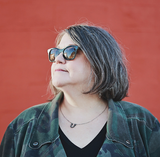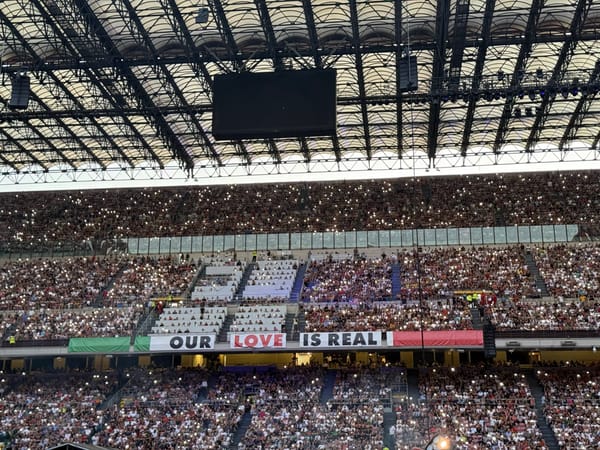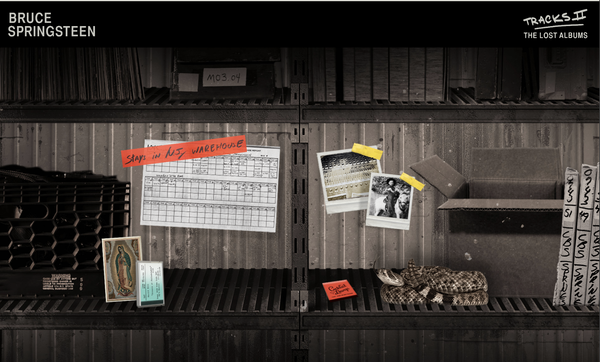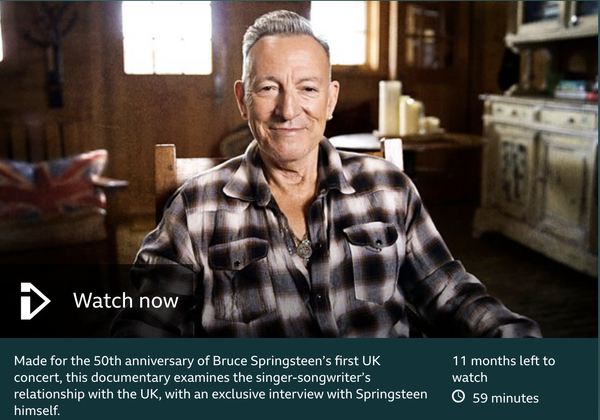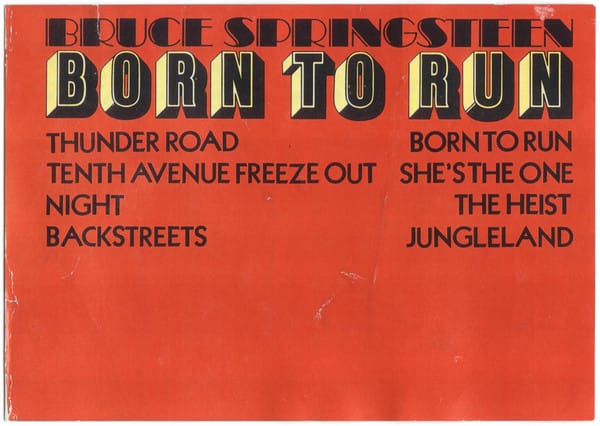Live Archive: Bruce Springsteen, Pontiac Theatre, Vancouver, BC, August 13, 2005
"The last night of our summer extravaganza."

Setlist: LIVING PROOF / REASON TO BELIEVE / DEVILS & DUST / LONESOME DAY / LONG TIME COMIN' / BECAUSE THE NIGHT / THE PROMISE / THE RIVER / STATE TROOPER / AIN'T GOT YOU / CYNTHIA / THE LINE / RENO / JANEY, DON'T YOU LOSE HEART / PARADISE / REAL WORLD / THE RISING / DARKNESS ON THE EDGE OF TOWN / JESUS WAS AN ONLY SON / TWO HEARTS / THE HITTER / MATAMOROS BANKS / BLINDED BY THE LIGHT / 4TH OF JULY, ASBURY PARK (SANDY) / THE PROMISED LAND / DREAM BABY DREAM
“Evening Vancouver! It’s nice to be here, thanks a lot. I guess my only request is for as much quiet as I can get tonight, that way I can give you my best. So enjoy yourselves!”
In 2005, Bruce Springsteen embarked on a tour to support Devils & Dust. The tour was just Bruce, a guitar, and an assortment of instruments through which he fashioned an evening that was acoustically-based. Like on the Ghost of Tom Joad tour, he’d ask for quiet, both from the stage and via handouts distributed to the audience. Sometimes it worked, sometimes it didn’t. But tonight in Vancouver he has an audience who is willing to listen to Springsteen’s presentation of revamped catalog material alongside more conventional presentations of both new and old songs.
With that as the background, it’s not just remarkable that Bruce pulled out “Living Proof” as an opener, it’s that it was performed on a small pump organ, tight and compact, and set the stage for the evening, demonstrating that it was going to be different than a usual evening with Bruce Springsteen, where he would be performing what he’d later refer to as his magic trick, conjuring these songs into life through manual effort and breath and air.
The writer Anne Lamott published a book in 2012 titled Help Thanks Wow, because that was how Lamott distilled the main themes of prayer. In its original form, “Living Proof” fit into that category although it probably wouldn’t be your first impression. But on the pump organ, and without those ringing guitar-thronged verses and bridges, it was an offering, it was undeniable.
Aside from a series of electric and acoustic guitars, the main instruments Bruce Springsteen utilized for the Devils & Dust tour were, as follows: electric piano, pump organ, dobro, autoharp, ukulele, a “stomping board” and a type of banjo (it isn’t a banjo, it’s a “banjitar,” which is a 6-string guitar with banjo strings and the same resonance as a banjo, so you’re not having to learn a completely new instrument). There was an offstage keyboard player (Bruce’s keyboard tech, Alan Fitzgerald) when necessary, some additional secret sauce triggered by guitar tech Kevin Buell offstage, and also various loops and other prerecorded techniques that Bruce could trigger through effects pedals. This is all important to know before the next song, one of the tour’s trademark transformations that would then spill over into later outings, “Reason to Believe.”
“Reason to Believe” on D&D was manifest from the bare minimum, a harmonica and a bullet microphone with a healthy dose of distortion alongside a sustaining organ chord continually looping alongside the aforementioned stomping board for a rhythm section. “Reason to Believe” is -- it was always -- a blues, and now he’s stripped it down to component parts and put them back together.
It feels like these creative remixings have largely gotten memory-holed in the ensuing 20 years. Not that he inverted or pioneered this kind of deconstruction in rock and roll but people go to a Bruce Springsteen show for certain things, and instead of just rolling out the tried and true, Bruce and an acoustic guitar and maybe a harmonica, he decided instead to see where he could take the songs apart and put them back together in a slightly updated way that also caused you, the audience, to appreciate the song from a different perspective, for it to enter your ear canal and your brain in a completely unfamiliar way.
20 years ago, this was not what many people were hoping to see when they bought a ticket to see Bruce Springsteen, and it was regarded as both heresy and betrayal at some level to certain folks, who still showed up. (In some ways, it’s not that far away from how some people feel about going to see Bob Dylan in the last 20-30 years.) There was also a camp of folks who thought it was all a big joke and wouldn’t (or couldn’t) take it seriously. With the benefit of time and distance, this official archive release from the concluding run on this tour grants us the ability to examine this outing anew. I think that Bruce Springsteen is one of our greatest living songwriters and that his songs are durable enough to be reconfigured and reexamined and that they benefit from this type of experiment, and I’d like to see more of it, not less.
The third song in the set is a straight-ahead rendition of “Devils & Dust” on 12 string acoustic guitar and you can almost hear the relief in the applause at the intro: oh, okay, the whole show isn’t going to be like that. Bruce is smart and understands how an audience works. He’s going to take advantage of the audience’s initial welcoming enthusiasm at the start of the show for two songs in unconventional arrangements, before giving them a handful of acoustic numbers.
With this song in particular I’m struck by how good a song this is, and how Bruce doesn’t get enough credit for this era of protest songs. He was critical of the people in power while never ever turning his back on the men and women who had the responsibility of carrying out their orders, or the impact these actions on everyday people. He wasn’t trying to hide or obscure his opinion but there’s no way he couldn’t be thinking about what happened 20 years earlier when he tried to have a public opinion in a more obvious fashion. No politicians are quoting “Devils & Dust” or “Living In the Future” or “Hey Blue Eyes” when they make speeches but it doesn’t mean they aren’t as important as “Born In The USA.”.
“Lonesome Day” isn’t much different than the album version but that somehow ends up reflecting its underlying deep sorrow and desperation even more. Like, this isn’t accidental, he’s too smart about these things, he knows what he’s doing. Also worth noting is his absolute command of the instrument, not something that is new or different, but getting to hear these performances with just Bruce, no band, makes them shine even harder.
This was one of the weeks that Bruce had a special guest on the road, as he introduces his oldest son Evan as he brings out a guitar before the next song. “Long Time Coming” is not one of the stronger songs on the record but it’s definitely a popular one, with a rousing, singable chorus. But it serves an important role within this tour’s setlist because it demonstrates the joyous moments, when it was just Bruce’s voice, when he’d step just slightly off-mic and let the air and the space of the venue do its thing.
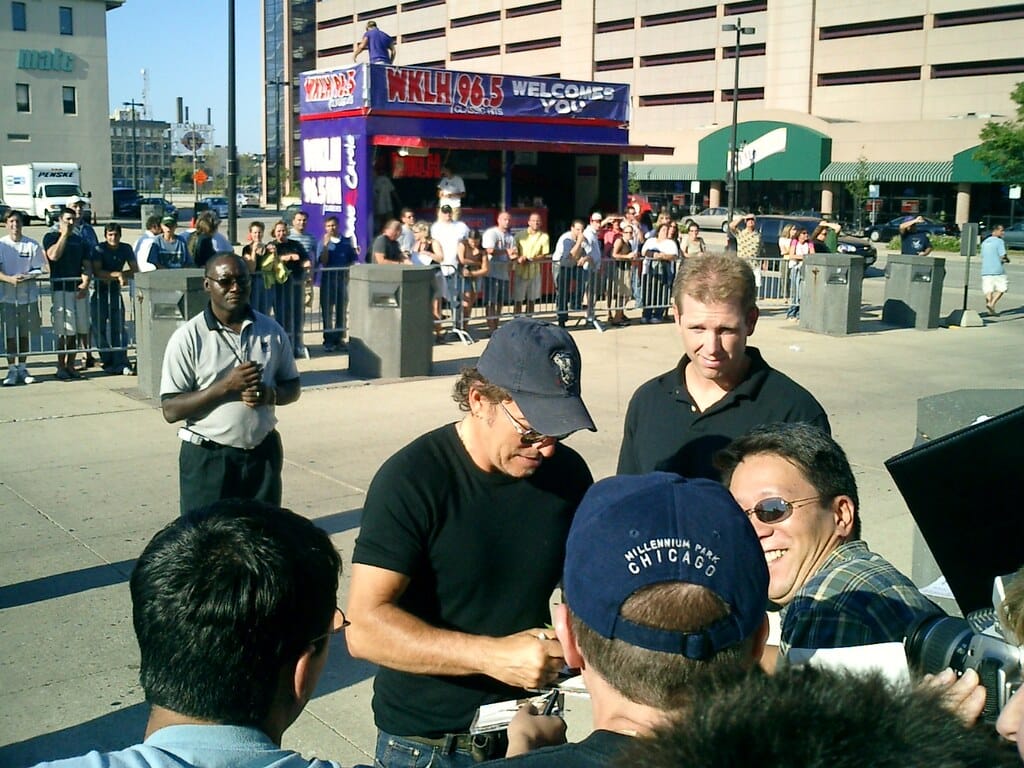
It’s one of the reasons that the arena leg of this tour was less satisfying than the one in theaters, but Bruce still did his best to maintain the intimacy he’d created in the initial run even as he moved into the larger places. At no point did he abandon the new arrangements or weird instrumentation just because they were at the Corporate Arena vs the Paramount Theater (in any city. It doesn’t matter which city).
At the song’s conclusion, he points out: “Evan always informs me that that last verse should actually have been ‘I ain’t gonna fuck it up too bad this time,’ that there should have been a qualifier. He’s getting a little smug.”
“Every night I try to do something I haven’t done before,” Bruce tells the audience, explaining that he wanted to do something for “the last night of our summer extravaganza.” He also mentioned that there are a lot of chords on this one -- “my piano skills are challenged.” The culprit in question is a version of “Because the Night” on the electric piano (for the first and only time on this tour) and despite Bruce’s apologies, none of them were needed. The electric piano is totally the right call for this one, a version that is eerie and dark and haunting and hollow, it’s a goth version of BTN here, and it’s an absolutely valid and exceedingly satisfying interpretation.
The audience agrees, bursting into rapturous applause at its conclusion. Bruce chuckles dryly in acknowledgement, sounding like both disbelief that he pulled it off and also relief that it’s over.
“This was a guy had a big sign out back, he made the effort to make the sign, probably took all of five minutes,” he chuckles, touching the piano in warmup before hitting the intro chords. “The Promise” is the request, Bruce at the piano, always a delight in this particular song especially. It’s followed by a stunning version of “The River” with a haunting wordless falsetto outro. Bruce favored the falsetto as a device on this tour, probably for the first time since the early 70s. It was just another instrument to be utilized, along with everything else in his bag of tricks.
Next, he’s tuning up on a guitar with these beautiful clouds of single notes that are also easing him into the next song, and then there’s that droning rhythm and “New Jersey Turnpike / riding on a wet night.” His voice is higher pitched than it is on the original, almost a continuation of the same vocal range as the falsetto. It’s a version of “State Trooper” that wouldn’t have been out of place being performed by the Cramps, just voice and space and that driving atonal rhythm. Obviously, “State Trooper” has long been noted for its similarities to what Suicide were doing at the time, and the Cramps are well within that same lineage, crazy dark instead of just -- dark dark.
“Often, very often, I’m on the street and folks ask me the same question all the time: what’s it feel like to be The Boss? I usually feed them some line of humble bullshit - oh it’s no big deal, it’s like anything else, it’s just a job my friend, a man’s gotta do what a man’s gotta do, somebody’s gotta do it. it’s carried me this far, I’m sticking with it. The reason i can’t actually let on -- you know, I can’t really let on -- well -- I guess it is just us here tonight, so, and I'm sure there’s not going to be anybody going to the internet when I'm done, so in that case -- “
**CHORD**
*CACKLE*
Despite that anecdote (or maybe because of it), he keeps that already established vibe going with what can only be described as a Buddy Holly on acid introduction to Tunnel of Love’s “Ain’t Got You.” It’s really psychobilly and kind of a great recontextualizing of a song that’s already intended to be sarcastic. It’s more interesting with this extra texture.
Bruce hits some chords and you can hear him say, “Might be out of tune!” only to immediately walk it back to “Nope, it’s me” and he carries on with “Cynthia.” My problem with “Cynthia” is that there’s a reason it never made a record. There’s better Bruce songs about girls! “I just like knowing, Cynthia, you exist, in a world like this.” is a great line, though, I’ll give him that, and the Roy Orbison imitation towards the end of the song, a hallmark of this tour's rendition, is lovely. He’s also trying to give the audience a palate cleanser because we’ve come out of a dark tunnel before heading into another hairpin turn.
That’s the segue taking us to “The Line” and then “Reno,” and then he’ll break that up again with “Janey Don’t You Lose Heart.” You have to admire the artistry with which he constructed these setlists, they are like driving down a road where you’re in the hollows and then crest upward for a song or two before dropping deeper next time. You can’t ever judge a show by just looking at the setlist and on this tour in particular with the revisions and the alternate versions you absolutely cannot. But with the benefit of time and distance I think I appreciate this tour even more because of the way he routed the audience on this particular journey. What he picked for the upbeats, the way he threaded the bleaker material.
So the pairings in the back half of the set here are “The Line” and “Reno,” “Paradise” and “Real World,” “The Rising” and “Darkness On The Edge of Town” and then ”The Hitter” into “Matamoros Banks.” Some of these were familiar from other shows, but even when there were substitutions it was the same rising and falling of the emotional waves. And unlike other tours, he really did keep the album he was touring behind as a main focus and not an afterthought. He kept at least 6 songs in from start to finish, letting the stronger material, or at least the material that worked the best in the Venn diagram of the stripped down instrumentation and the thematic pairings.
Another hallmark of this tour was how he kept introducing different material into the set, he could have just figured out the narrative arc that worked for him and been consistent for the entirety of this tour, it would have been easier but it would have been far less interesting. The variations are interesting not from a song collection standpoint -- I don’t know how anyone could chase this particular outing just to knock out their own personal setlist quest -- but because he was always experimenting and seeing what people were asking for and figuring out how to make it work. There were no signs in the audience but the time-honored tradition of standing at the stage door as Bruce entered still could work, as demonstrated tonight with “The Promise.” In my mind that was someone in that part of the country shooting their shot, knowing they’d never make it to the East Coast to see it happen.
I disliked “Reno” when it came out because I didn’t think it was a particularly great song. I still don’t think it’s a very good song but I do think he has some decent writing in it. I think that listening to these songs in these performances is illustrative in letting you see the standout lyrics, and I thought of that in hearing both “The Hitter” and “Matamoros Banks.” In “The Hitter,” it’s one of those drop-dead opening lines: “Come to the door, ma, and unlock the chain.” It’s mistakenly simple but it delivers so much information: we know where he is, we know the door is locked, we know he has a key, changing the locks is expensive or something you can’t do if you’re renting, but the person who lives there has an interest in preventing the narrator from entering. He makes the request again so the entire song is delivered standing outside the door, through the small crack that the chain allows.
In “Matamoros” it’s the line about the turtles, which is something he learned by reading about what happens to people crossing the southern border. And in “Reno,” the superlative line is “the sun bloodied the sky / And sliced through the hotel blinds” and the reason that stands out is the jump cuts in the narrative, and that again, he’s giving you information, the time of day, the location. I still think it’s a song that should’ve stayed in the notebook because it’s not that interesting and if you’re going to cash that chip in (and get yourself banned from the register at Starbucks in the process, not that that actually mattered) then make sure it’s a song worth the battle.
“Janey Don’t You Lose Heart” is the top of the hill, before going back down again for “Paradise” on piano. This particular rearrangement allows you to reflect on his ability to write from difficult perspectives, it’s yet another element of his work that I think gets overlooked. It’s hard when you have so many truly great upbeat songs to get anyone to sit down and contemplate Bruce’s willingness to write from drastically different viewpoints, some not all that sympathetic from the outside.
He always says some variation of, “If I can do it for myself I’ll probably help someone else” and I think he’s resigned to the fact that no one pays attention to the lyrics. But it’s got to be deeply frustrating on some level that careful writing about important subjects gets zero attention, or at least less than songs of lesser quality that just have a better chorus. The switch between regular piano to electric piano here is oddly, deliberately unsettling.
The segue of “Real World” / “The Rising” / “Darkness on the Edge of Town” is a well-matched, deeply thought out and just plain great collection of songs before heading to the next hillcrest, even though there is something melancholy in “Jesus Was An Only Son.” “Two Hearts” is on acoustic guitar and it’s a nice palate cleanser. I get its value from that perspective, but I do wonder if we couldn’t have trimmed a song or two out of this show for stronger impact. I do admire how bulletproof it is as a pop tune.
I like the inspiration for “Jesus Was An Only Son,” how he wanted to write about Jesus as though he was just another person -- “They could have saved the preaching for the weekends,” Bruce relates in the introduction, walking us through the concept of Jesus and Mary Magdalene in another universe, where they get themselves a little bar on the shore of the Sea of Galilee -- but that isn’t the song he ended up writing! It is a good pairing with “Two Hearts,” though, and I think the matchup elevates and illuminates both songs and creates a nice place of warmth and comfort that we’re going to need before the next pairing.
“I want to just say that we carry the seeds of creation, it’s a miracle enough in itself, and to build things, and to throw love out into the world, and we also carry the seeds of our own destruction,” Bruce begins his introduction to the next song. “I suppose that’s what makes life interesting, I guess that came with the whole ‘east of Eden’ thing. I've been telling the folks each night that I have a theory, that the whole garden of Eden thing was rigged, rigged from the very top. And the more I've thought about it -- okay, there’s a garden. I mean, that can be boring enough, let's face it. But there you are, and you can walk anywhere you want, right? BUT you can’t touch this one tree.
Exasperated exhale from Bruce, probably a quizzical expression based on the light laughter from the audience
“I mean, who’s he talking to? You can't touch that one tree, you can touch all the other trees, but you can’t touch that one. I mean, how many times can you walk around the garden? I mean, you’re going to walk around the garden quite a bit but you’re gonna keep coming back to the tree. And it’s the interesting tree, because it’s the one with the talking snake in it. No talking animals in any of the other trees! That’s what I mean, it’s a set up, the whole thing was a set up.
"So my theory is – we’re better off, that’s my theory. It’s made life much more interesting and dangerous, however, so… this is 'The Hitter.'
It’s taken me 20 years to realize the intro to this song sounds like the intro to “Hard Rain” for a few seconds. “The Hitter” always had some kind of mythological status as an outtake. Long before this song made the record, in any online Springsteen forum there were always at least one or two Serious Dudes who had that in their screen name, and I was always perplexed by that status based on the one rough outtake I’d heard along the way. I think that the final version is a very, very good song, but we have also never heard it since. That doesn’t necessarily mean anything in particular, because we’re talking about the guy who recorded “Roulette” and then didn’t use it on the record. (I realize there are other examples, absence is not necessarily a barometer of quality, that’s always my top go-to.)
We’ve already talked a little bit about “Matamoros Banks,” coming up next, and while doing the work to write this essay I had to keep reminding myself that it was not on The Ghost of Tom Joad even though (as Bruce himself notes below) that is not a terrible faux pas, they are indeed connected.
“I lived in California for three or four years, and I wrote a series of songs set along the southern border and into the Central Valley, for The Ghost of Tom Joad. This song was a sequel to that group of songs. Every year there’s hundreds of people who die trying to cross the southern border of the United States, and they die from dehydration in the desert during the summers and they die trying to cross the river, in the backs of vans, struggling to get into the country just to do the toughest and the dirtiest jobs that we have. This is a song called ‘Matamoros Banks’ and I wrote this song backwards, first verse is from the point of view of the body at the bottom of the river and the last verse is a man standing on the river bank of the Rio Grande across from Brownsville, TX.
The songs on Joad, and anything adjacent (like this one) always seem to be studiously omitted in any discussion of the entire body of work. Folks that readily glom onto Nebraska with enthusiasm are nowhere to be found when discussing GOTJ. Intellectually, I think that I understand that. Relatively speaking, the material on Nebraska seems lighter because there is dark humor in some places and also because they are characters, even if they were based on real people’s stories, while nothing on Joad is abstract. You can pick up a newspaper in any year and find similar if not identical stories. And I know what I just said about his political songs getting too much attention and so he chose different approaches moving forward, no one is ever talking about the Joad songs as political, which they 1,000,000% are, and not just because it’s 2025.
“This was a song I always prefaced by saying it explains why I never did any drugs - I was already psychotic, I think. But I am going to be doing some drugs, I'm not exactly sure when, but I will be doing them, kind of been saving it for my old age, give me something to do. But in the meantime -- [guitar strings tune up] There it is!” Bruce says with some relief.
A Dude yells a very loud YEAHHHH
“I haven’t even played it yet, but I thank you for that response, my friend -- wait until you hear the damn thing. You’re gonna go twice as crazy, I guarantee it.”
I love an acoustic “Blinded By The Light” because it’s kind of like a way to admire the wordplay without anything else getting in the way, the era of tearing up the rhyming dictionary, of writing for the sheer joy of putting words on a page and then writing music to fit them, sitting in the back of the beauty parlor on Cookman Avenue, teaching himself how to be a songwriter.
“This is our last summer show and I want to thank all of you. I want to thank all of my professional stalkers who have been following me around. There’s a small group of people, they’ve moved from friend to stalker, I’ve decided -- friendly stalking, but stalking just the same, so I’d like to thank them, and all the folks that made it such a nice summer for me. It takes a dedicated audience and I appreciate it. So I’m going to wish you a merry rest of your summer…this is for you guys.”
There is enthusiastic applause at the first note.
“You don’t know what it is! You might not like it!”
Of course, that admonition is for naught because as soon as he says the word “Sandy” the place erupts in applause. “4th of July, Asbury Park” is up next, and it feels like that first day on the beach at the end of the summer where overnight the weather has shifted just the tiniest bit, just enough to signal that fall is on its way.
He gives a shout-out to the Greater Vancouver Food Bank, and then dedicates the next song to them. “Promised Land” into “Dream Baby Dream” is a pairing I loved at the time but it hits even more deeply now all these years later, and especially in 2025. “The Promised Land” is, as always, a statement of intent, a declaration of faith, it is the serious work, it is the affirmation. But “Dream Baby Dream” is both the polar opposite and the other half of that covenant. I see it as a parallel expression of the misquoted Emma Goldman quote about unless she could dance, she didn’t want to be part of the revolution.
What she actually said was, “I did not believe that a Cause which stood for a beautiful ideal, for anarchism, for release and freedom from conventions and prejudice, should demand the denial of life and joy…If it meant that, I did not want it.” What I hear in this matchup is a corollary to that, that America is a promise but it is also a dream, and it is the promise in which we should all be able to dream. The two songs together side by side here are almost dual hymns, the pump organ sounding more like the sacred rhythm of a harmonium, the repetition generating energy until he decides it's time to wind down, take that final breath for the night, to put his tools down and walk away.

